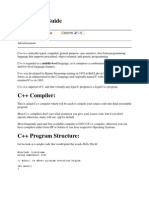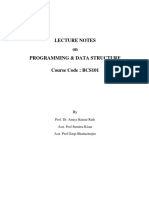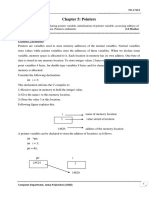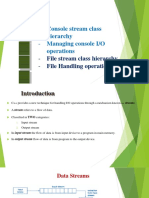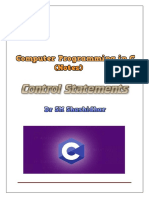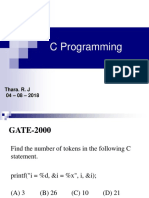C++ Tutorials
Uploaded by
ukargyiC++ Tutorials
Uploaded by
ukargyiTutorials Point, Simply Easy Learning
C++ Tutorial Tutorialspoint.com
C++ is a middle-level programming language developed by Bjarne Stroustrup starting in 1979 at Bell Labs. C++ runs on a variety of platforms, such as Windows, Mac OS, and the various versions of UNIX. This tutorial gives an initial push to start you with C++. For more detail kindly check tutorialspoint.com/cplusplus C++ is a statically typed, compiled, general purpose, case-sensitive, free-form programming language that supports procedural, object-oriented, and generic programming. C++ is regarded as a middle-level language, as it comprises a combination of both high-level and low-level language features. C++ was developed by Bjarne Stroustrup starting in 1979 at Bell Labs in Murray Hill, New Jersey as an enhancement to the C language and originally named C with Classes but later it was renamed C++ in 1983. C++ is a superset of C, and that virtually any legal C program is a legal C++ program.
C++ Compiler:
This is actual C++ compiler which will be used to compile your source code into final executable program. Most C++ compilers don't care what extension you give your source code, but if you don't specify otherwise, many will use .cpp by default
1|Page
Tutorials Point, Simply Easy Learning
Most frequently used and free available compiler is GNU C/C++ compiler, otherwise you can have compilers either from HP or Solaris if you have respective Operating Systems.
C++ Program Structure:
Let us look at a simple code that would print the words Hello World.
#include <iostream> using namespace std; // main() is where program execution begins. int main() { cout << "Hello World"; // prints Hello World return 0; }
Comments in C++
C++ supports single line and multi-line comments. All characters available inside any comment are ignored by C++ compiler. C++ comments start with /* and end with */. For example:
/* This is a comment */ /* C++ comments can also * span multiple lines */
A comment can also start with //, extending to the end of the line. For example:
#include <iostream> using namespace std; main() { cout << "Hello World"; // prints Hello World return 0; }
C++ Primitive Built-in Types:
C++ offer the programmer a rich assortment of built-in as well as user defined data types. Following table list down seven basic C++ data types: Type Boolean bool Keyword
2|Page
Tutorials Point, Simply Easy Learning
Character Integer Floating point Double floating point Valueless Wide character char int float double void wchar_t
Variable Declaration & Initialization in C++:
Some examples are:
int d = 3, f = 5; byte z = 22; double pi = 3.14159; char x = 'x';
// // // //
initializing d and f. initializes z. declares an approximation of pi. the variable x has the value 'x'.
C++ Variable Scope:
A scope is a region of the program and broadly speaking there are three places where variables can be declared: 1. 2. 3. Inside a function or a block which is called local variables, In the definition of function parameters which is called formal parameters. Outside of all functions which is called global variables.
C++ Constants/Literals:
Constants refer to fixed values that the program may not alter and they are called literals. Constants can be of any of the basic data types and can be divided in Integer Numerals, Floating-Point Numerals, Characters, Strings and Boolean Values. Again, constants are treated just like regular variables except that their values cannot be modified after their definition.
C++ Modifier Types:
C++ allows the char, int, and double data types to have modifiers preceding them. A modifier is used to alter the meaning of the base type so that it more precisely fits the needs of various situations. The data type modifiers are listed here:
signed unsigned
3|Page
Tutorials Point, Simply Easy Learning
long short
The modifiers signed, unsigned, long, and short can be applied to integer base types. In addition, signed and unsigned can be applied to char, and long can be applied to double. The modifiers signed and unsigned can also be used as prefix to long or short modifiers. For example unsigned long int. C++ allows a shorthand notation for declaring unsigned, short, or long integers. You can simply use the word unsigned, short, or long, without the int. The int is implied. For example, the following two statements both declare unsigned integer variables.
unsigned x; unsigned int y;
Storage Classes in C++:
A storage class defines the scope (visibility) and life time of variables and/or functions within a C++ Program. These specifiers precede the type that they modify. There are following storage classes which can be used in a C++ Program
auto register static extern mutable
C++ Operators:
An operator is a symbol that tells the compiler to perform specific mathematical or logical manipulations. C++ is rich in built-in operators and provides following type of operators:
Arithmetic Operators ( +, -, \, *, ++, --) Relational Operators (==, !=, >. <, >=, <=) Logical Operators (&&, ||, ! ) Bitwise Operators (& |, ^, ~, <<, >>) Assignment Operators (=, +=, -=, *=, /=, %=, <<=, >>=, &=, ^=, |=) Misc Operators ( sizeof, & cast, comma, conditional etc.)
C++ Loop Types:
C++ programming language provides following types of loop to handle looping requirements. Click the following links to check their detail. Loop Type while loop Description Repeats a statement or group of statements until a given condition is true. It tests the condition before executing the loop body. Execute a sequence of statements multiple times and abbreviates the code that manages the loop variable.
for loop
4|Page
Tutorials Point, Simply Easy Learning
do...while loop Like a while statement, except that it tests the condition at the end of the loop body You can use one or more loop inside any another while, for or do..while loop.
nested loops
C++ Decision Making:
C++ programming language provides following types of decision making statements. Click the following links to check their detail. Statement if statement Description An if statement consists of a boolean expression followed by one or more statements. An if statement can be followed by an optional else statement, which executes when the boolean expression is false. A switch statement allows a variable to be tested for equality against a list of values. You can use one if or else if statement inside another if or else if statement(s). You can use one swicth statement inside another switch statement(s).
if...else statement
switch statement
nested if statements
nested switch statements
C++ Functions:
The general form of a C++ function definition is as follows:
return_type function_name( parameter list ) { body of the function }
A C++ function definition consists of a function header and a function body. Here are all the parts of a function:
Return Type: A function may return a value. The return_type is the data type of the value the function returns. Some functions perform the desired operations without returning a value. In this case, the return_type is the keyword void. Function Name: This is the actual name of the function. The function name and the parameter list together constitute the function signature. Parameters: A parameter is like a placeholder. When a function is invoked, you pass a value to the parameter. This value is referred to as actual parameter or argument. The
5|Page
Tutorials Point, Simply Easy Learning
parameter list refers to the type, order, and number of the parameters of a function. Parameters are optional; that is, a function may contain no parameters. Function Body: The function body contains a collection of statements that define what the function does.
Numbers in C++:
Following a simple example to show few of the mathematical operations on C++ numbers:
#include <iostream> #include <cmath> using namespace std; int main () { // number definition: short s = 10; int i = -1000; long l = 100000; float f = 230.47; double d = 200.374; // mathematical operations; cout << "sin(d) :" << sin(d) << endl; cout << "abs(i) :" << abs(i) << endl; cout << "floor(d) :" << floor(d) << endl; cout << "sqrt(f) :" << sqrt(f) << endl; cout << "pow( d, 2) :" << pow(d, 2) << endl; return 0; }
C++ Arrays:
Following is an example which will show array declaration, assignment and accessing arrays in C++:
#include <iostream> using namespace std; #include <iomanip> using std::setw; int main () { int n[ 10 ]; // n is an array of 10 integers // initialize elements of array n to 0 for ( int i = 0; i < 10; i++ ) { n[ i ] = i + 100; // set element at location i to i + 100 } cout << "Element" << setw( 13 ) << "Value" << endl; // output each array element's value for ( int j = 0; j < 10; j++ ) { cout << setw( 7 )<< j << setw( 13 ) << n[ j ] << endl;
6|Page
Tutorials Point, Simply Easy Learning
} return 0; }
C++ Strings:
C++ provides following two types of string representations: The C-style character string as follows:
char greeting[6] = {'H', 'e', 'l', 'l', 'o', '\0'};
The standard C++ library provides a string class type that supports all the operations mentioned above, additionally much more functionality. Following is the example:
#include <iostream> #include <string> using namespace std; int main () { string str1 = "Hello"; string str2 = "World"; string str3; // copy str1 into str3 str3 = str1; cout << "str3 : " << str3 << endl; // concatenates str1 and str2 str3 = str1 + str2; cout << "str1 + str2 : " << str3 << endl; return 0; }
C++ Classes & Objects
A class definition starts with the keyword class followed by the class name; and the class body, enclosed by a pair of curly braces. A class definition must be followed either by a semicolon or a list of declarations. For example we defined the Box data type using the keyword class as follows:
class Box { public: double length; double breadth; double height; };
// Length of a box // Breadth of a box // Height of a box
The keyword public determines the access attributes of the members of the class that follow it. A public member can be accessed from outside the class anywhere within the scope of the class
7|Page
Tutorials Point, Simply Easy Learning
object. You can also specify the members of a class as private or protected which we will discuss in a sub-section.
Define C++ Objects:
A class provides the blueprints for objects, so basically an object is created from a class. We declare objects of a class with exactly the same sort of declaration that we declare variables of basic types. Following statements declare two objects of class Box:
Box Box1; Box Box2;
// Declare Box1 of type Box // Declare Box2 of type Box
Both of the objects Box1 and Box2 will have their own copy of data members.
Accessing the Data Members:
The public data members of objects of a class can be accessed using the direct member access operator (.). Let us try following example to make the things clear:
#include <iostream> using namespace std; class Box { public: double length; double breadth; double height; };
// Length of a box // Breadth of a box // Height of a box
int main( ) { Box Box1; // Declare Box1 of type Box Box Box2; // Declare Box2 of type Box double volume = 0.0; // Store the volume of a box here // box 1 specification Box1.height = 5.0; Box1.length = 6.0; Box1.breadth = 7.0; // box 2 specification Box2.height = 10.0; Box2.length = 12.0; Box2.breadth = 13.0; // volume of box 1 volume = Box1.height * Box1.length * Box1.breadth; cout << "Volume of Box1 : " << volume <<endl; // volume of box 2 volume = Box2.height * Box2.length * Box2.breadth; cout << "Volume of Box2 : " << volume <<endl; return 0; }
C++ Inheritance:
8|Page
Tutorials Point, Simply Easy Learning
One of the most important concepts in object-oriented programming is that of inheritance. Inheritance allows us to define a class in terms of another class, which makes it easier to create and maintain an application. This also provides an opportunity to reuse the code functionality and fast implementation time. When creating a class, instead of writing completely new data members and member functions, the programmer can designate that the new class should inherit the members of an existing class. This existing class is called the base class, and the new class is referred to as the derived class. A class can be derived from more than one classes, which means it can inherit data and functions from multiple base classes. To define a derived class, we use a class derivation list to specify the base class(es). A class derivation list names one or more base classes and has the form:
class derived-class: access-specifier base-class
Where access-specifier is one of public, protected, or private, and base-class is the name of a previously defined class. If the access-specifier is not used, then it is private by default. Consider a base class Shape and its derived class Rectangle as follows:
#include <iostream> using namespace std; // Base class class Shape { public: void setWidth(int w) { width = w; } void setHeight(int h) { height = h; } protected: int width; int height; }; // Derived class class Rectangle: public Shape { public: int getArea() { return (width * height); } }; int main(void) { Rectangle Rect; Rect.setWidth(5); Rect.setHeight(7);
9|Page
Tutorials Point, Simply Easy Learning
// Print the area of the object. cout << "Total area: " << Rect.getArea() << endl; return 0; }
C++ Overloading
C++ allows you to specify more than one definition for a function name or an operator in the same scope, which is called function overloading and operator overloading respectively. Following is the example where same function print() is being used to print different data types:
#include <iostream> using namespace std; class printData { public: void print(int i) { cout << "Printing int: " << i << endl; } void print(double f) { cout << "Printing float: " << f << endl; } void print(char* c) { cout << "Printing character: " << c << endl; } }; int main(void) { printData pd; // Call print to print integer pd.print(5); // Call print to print float pd.print(500.263); // Call print to print character pd.print("Hello C++"); return 0; }
Polymorphism in C++
C++ polymorphism means that a call to a member function will cause a different function to be executed depending on the type of object that invokes the function. Consider the following example where a base class has been derived by other two classes and area() method has been implemented by the two sub-classes with different implementation.
#include <iostream>
10 | P a g e
Tutorials Point, Simply Easy Learning
using namespace std; class Shape { protected: int width, height; public: Shape( int a=0, int b=0) { width = a; height = b; } int area() { cout << "Parent class area :" <<endl; return 0; } }; class Rectangle: public Shape{ public: Rectangle( int a=0, int b=0) { Shape(a, b); } int area () { cout << "Rectangle class area :" <<endl; return (width * height); } }; class Triangle: public Shape{ public: Triangle( int a=0, int b=0) { Shape(a, b); } int area () { cout << "Rectangle class area :" <<endl; return (width * height / 2); } }; // Main function for the program int main( ) { Shape *shape; Rectangle rec(10,7); Triangle tri(10,5); // store the address of Rectangle shape = &rec; // call rectangle area. shape->area(); // store the address of Triangle shape = &tri; // call triangle area. shape->area(); return 0; }
11 | P a g e
Tutorials Point, Simply Easy Learning
Data Abstraction in C++:
Data abstraction refers to, providing only essential information to the outside word and hiding their background details ie. to represent the needed information in program without presenting the details. Data abstraction is a programming (and design) technique that relies on the separation of interface and implementation. For example, in C++ we use classes to define our own abstract data types (ADT). You can use the cout object of class ostream to stream data to standard output like this:
#include <iostream> using namespace std; int main( ) { cout << "Hello C++" <<endl; return 0; }
Here you don't need to understand how cout displays the text on the user's screen. You need only know the public interface and the underlying implementation of cout is free to change.
Data Encapsulation in C++:
All C++ programs are composed of following two fundamental elements: 1. 2. Program statements (code): This is the part of a program that performs actions and they are called functions. Program data: The data is the information of the program which affected by the program functions.
Encapsulation is an Object Oriented Programming concept that binds together the data and functions that manipulate the data, and that keeps both safe from outside interference and misuse. Data encapsulation led to the important OOP concept of data hiding. C++ supports the properties of encapsulation and data hiding through the creation of userdefined types, called classes. We already have studied that a class can contain private, protected and public members. By default, all items defined in a class are private. For example:
class Box { public: double getVolume(void) { return length * breadth * height; } private: double length; // Length of a box double breadth; // Breadth of a box double height; // Height of a box };
C++ Files and Streams:
12 | P a g e
Tutorials Point, Simply Easy Learning
The iostream standard library cin and cout methods for reading from standard input and writing to standard output respectively. To read and write from a file requires another standard C++ library called fstream which defines three new data types: Data Type ofstream Description This data type represents the output file stream and is used to create files and to write information to files. This data type represents the input file stream and is used to read information from files. This data type represents the file stream generally, and has the capabilities of both ofstream and ifstream which means it can create files, write information to files, and read information from files.
ifstream
fstream
Following is the C++ program which opens a file in reading and writing mode. After writing information inputted by the user to a file named afile.dat, the program reads information from the file and outputs it onto the screen:
#include <fstream> #include <iostream> using namespace std; int main () { char data[100]; // open a file in write mode. ofstream outfile; outfile.open("afile.dat"); cout << "Writing to the file" << endl; cout << "Enter your name: "; cin.getline(data, 100); // write inputted data into the file. outfile << data << endl; cout << "Enter your age: "; cin >> data; cin.ignore(); // again write inputted data into the file. outfile << data << endl; // close the opened file. outfile.close(); // open a file in read mode. ifstream infile; infile.open("afile.dat");
13 | P a g e
Tutorials Point, Simply Easy Learning
cout << "Reading from the file" << endl; infile >> data; // write the data at the screen. cout << data << endl; // again read the data from the file and display it. infile >> data; cout << data << endl; // close the opened file. infile.close(); return 0; }
Further Detail: Refer to the link http://www.tutorialspoint.com/cplusplus
List of Tutorials from TutorialsPoint.com
Learn JSP Learn Servlets Learn log4j Learn iBATIS Learn Java Learn JDBC Java Examples Learn Best Practices Learn Python Learn Ruby Learn Ruby on Rails Learn SQL Learn MySQL Learn AJAX Learn C Programming Learn C++ Programming Learn CGI with PERL Learn DLL Learn ebXML Learn Euphoria Learn GDB Debugger Learn Makefile
Learn ASP.Net Learn HTML Learn HTML5 Learn XHTML Learn CSS Learn HTTP Learn JavaScript Learn jQuery Learn Prototype Learn script.aculo.us Web Developer's Guide Learn RADIUS Learn RSS Learn SEO Techniques Learn SOAP Learn UDDI Learn Unix Sockets Learn Web Services Learn XML-RPC Learn UML Learn UNIX Learn WSDL
14 | P a g e
Tutorials Point, Simply Easy Learning
Learn Parrot Learn Perl Script Learn PHP Script Learn Six Sigma Learn SEI CMMI Learn WiMAX Learn Telecom Billing
Learn i-Mode Learn GPRS Learn GSM Learn WAP Learn WML Learn Wi-Fi
webmaster@TutorialsPoint.com
15 | P a g e
You might also like
- C++ Quick Guide: #Include Using Namespace STD // Main Is Where Program Execution Begins. Int Main (100% (2)C++ Quick Guide: #Include Using Namespace STD // Main Is Where Program Execution Begins. Int Main (15 pages
- Create A Class Triangle Include Overload Function For Calculating Area - Overload Assignment Operator & Equality Operator56% (9)Create A Class Triangle Include Overload Function For Calculating Area - Overload Assignment Operator & Equality Operator4 pages
- 100 TOP C++ Programming Multiple Choice Questions and Answers C++ Programming Questions and Answers PDF78% (9)100 TOP C++ Programming Multiple Choice Questions and Answers C++ Programming Questions and Answers PDF24 pages
- Unit I: C++ and Object Oriented ProgrammingNo ratings yetUnit I: C++ and Object Oriented Programming51 pages
- 12 Computer Science Notes CH03 Data File HandlingNo ratings yet12 Computer Science Notes CH03 Data File Handling10 pages
- The Polish Notation (Application of Stacks)No ratings yetThe Polish Notation (Application of Stacks)23 pages
- Lecture 0 Algorithm Flowchart PseudocodeNo ratings yetLecture 0 Algorithm Flowchart Pseudocode26 pages
- Topic1: Passing and Returning Objects in C++: Passing An Object As Argument100% (1)Topic1: Passing and Returning Objects in C++: Passing An Object As Argument3 pages
- Computer Organization and Assembly Language. Semester Project: Description100% (1)Computer Organization and Assembly Language. Semester Project: Description11 pages
- Introduction To Computer Programming: Instructor: Mahwish ShahidNo ratings yetIntroduction To Computer Programming: Instructor: Mahwish Shahid46 pages
- Object Oriented Programming Lab-09 (Multiple Inheritance)No ratings yetObject Oriented Programming Lab-09 (Multiple Inheritance)5 pages
- Console Stream Class Hierarchy Managing Console I/O Operations100% (1)Console Stream Class Hierarchy Managing Console I/O Operations41 pages
- Object Oriented Programming Using C++ NOTESNo ratings yetObject Oriented Programming Using C++ NOTES96 pages
- C++ - Lecures - Compressed Google-Over ViewNo ratings yetC++ - Lecures - Compressed Google-Over View42 pages
- ဘလ္လာတိယပျို့လာ အပြောက်အမွမ်းများ လေ့လာချက်စာတမ်း - Dr. လှလှအောင်100% (1)ဘလ္လာတိယပျို့လာ အပြောက်အမွမ်းများ လေ့လာချက်စာတမ်း - Dr. လှလှအောင်19 pages
- Yk Hacwf Pmar yGJ: (Ä O' Edwd "MWKRMVM? 'VD' "Mwfü Upönf Usrf Udk Ukd Um Onf/)No ratings yetYk Hacwf Pmar yGJ: (Ä O' Edwd "MWKRMVM? 'VD' "Mwfü Upönf Usrf Udk Ukd Um Onf/)3 pages
- Burmese Archaic Old Book by Dwin Thin Min GyiNo ratings yetBurmese Archaic Old Book by Dwin Thin Min Gyi55 pages
- မဟာဂန္ဓာရုံဆရာတော်ရေးတဲ့ သိမ်အကြောင်း - သာမဏေကျော်No ratings yetမဟာဂန္ဓာရုံဆရာတော်ရေးတဲ့ သိမ်အကြောင်း - သာမဏေကျော်61 pages
- ( ) Posted by in Thursday, December 24, 2009No ratings yet( ) Posted by in Thursday, December 24, 200912 pages

